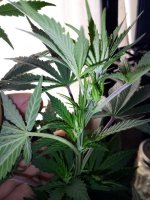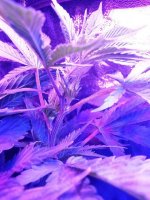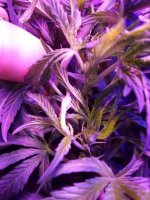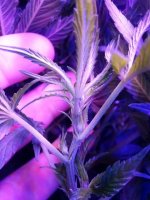Hello I have a plant that is about 100 days into a veg used to make clones and will eventually be planted outside light permitting. I noticed what looked like the first phase of flower where the node spacing gets very tight and a drastic increase in hairs. There was a period 8 days ago that I reduced the light intensity to snap a pic and forgot to change it back for12 hours. Did that single event flip her? Is it just her age showing? I gave her an extra shot of nitrogen yesterday.
-
ICMag with help from Landrace Warden and The Vault is running a NEW contest in November! You can check it here. Prizes are seeds & forum premium access. Come join in!
You are using an out of date browser. It may not display this or other websites correctly.
You should upgrade or use an alternative browser.
You should upgrade or use an alternative browser.
Mother plant entering flower on her own
- Thread starter grod31
- Start date
Hello I have a plant that is about 100 days into a veg used to make clones and will eventually be planted outside light permitting. I noticed what looked like the first phase of flower where the node spacing gets very tight and a drastic increase in hairs. There was a period 8 days ago that I reduced the light intensity to snap a pic and forgot to change it back for12 hours. Did that single event flip her? Is it just her age showing? I gave her an extra shot of nitrogen yesterday.
As long as there was light present the mother should not have switched to flower, it's not the intensity or even the length of the light period that trigger the plant to flower it's the length of the dark period that the meristem detects that causes it to flip. If the light period has been maintained for more then 12 hours (even if dimmed) then it's probably more along the lines of what f-e is suggesting that is the reason for the change.
Then again it kind of depends on what you mean by a drastic increase in hairs, it's kind of hard to judge without a picture. If by drastic increase you mean clumps of hairs close together in bunches then yeah that's flowering behavior. If on the other hand you mean the mother has just developed a lot more individual pre-flowers at more of the nodes then that could just be the age showing since plants will develop pre-flowers while still in the veg stage.
One way to minimize this is when you take clones take an extra clone or two to replace the mother then either grow out the mother with the rest of the clones you took or discard it after the clone you took to replace her shows roots and has been successfully potted. This will help to keep your mother more manageable in size as well and you'll have less worries of her becoming root bound eventually. Now technically a clone is just as mature as the mother it came from but since it has to re-establish itself from a small cutting at first most of it's energies will go towards growing in size and growing out leaves and nodes and such, once it reaches a sufficient size though then it should start developing pre-flowers roughly to the same degree it's mother was doing.
SeaDog_BC
New member
Most indcia & hybrid strains will flower at around 14 on / 10 off. Some even at 15/9. 12/12 became the default because it lets you flip flop your lights, not because it's a magic number that makes them flower.
If you're at 18/6 already light probably isn't the issue but you can try bumping it up to 20/4 anyways. If the pot they're in is too small that can cause the changes you're describing too.
If you're at 18/6 already light probably isn't the issue but you can try bumping it up to 20/4 anyways. If the pot they're in is too small that can cause the changes you're describing too.
I REALLY hope there is no shit autoflower genes in my beans. I specifically bought a strain that predated even low ryders#1. White Russian from serious seeds.
I have another mother right next to this one @ 70 days and it has not changed.
Is that a picture of the mother you're worried about? If so then I'm inclined to say that due to it's age it's just showing a lot of veg stage pre-flowers.
The difference between 70 days and 100 days can mean a world of difference.
In flowing terms, I don't see any problem there.
I do see something in the plants morphology I don't like. I gave up asking people to even recognise the issue over 10 years ago though. I see it often, but people seem to see it as normal.
I will explain. The terminal tip is a bit small. The branch leading to it a little short. These signs are accompanied by the more noticeable failure to open up. Leaves are sat vertically, looking strap like, when they should be moving towards horizontal. In this pic we have quite some advancement, where decent sized leaves are still vertical not horizontal. The petioles exhibiting the same lack of elongation seen in the branch supporting the tip.
I think this may follow a root disturbance, though isn't immediate. I think effort is going into rooting, as the plant realises there is an opportunity. I will also see this maybe 5 days into flower (5 days of 12/12) and think it's linked to calcium and perhaps one of the lesser used metals.
This is the second such post I have seen in a few days. People seem to go straight over it though, like it's nothing.
I do see something in the plants morphology I don't like. I gave up asking people to even recognise the issue over 10 years ago though. I see it often, but people seem to see it as normal.
I will explain. The terminal tip is a bit small. The branch leading to it a little short. These signs are accompanied by the more noticeable failure to open up. Leaves are sat vertically, looking strap like, when they should be moving towards horizontal. In this pic we have quite some advancement, where decent sized leaves are still vertical not horizontal. The petioles exhibiting the same lack of elongation seen in the branch supporting the tip.
I think this may follow a root disturbance, though isn't immediate. I think effort is going into rooting, as the plant realises there is an opportunity. I will also see this maybe 5 days into flower (5 days of 12/12) and think it's linked to calcium and perhaps one of the lesser used metals.
This is the second such post I have seen in a few days. People seem to go straight over it though, like it's nothing.
You sir have a keen eye. I dont know if it would complicate things or make more sense if i told you this isn't a "mother" rather a plant I am just growing really large to be planted in spring. For the sake of the conversation I assume it makes no difference.
I am gonna take a minute to try and fully understand what you are explaining to me.
I appreciate you sharing some knowledge.
What do you mean by the branch leading to the terminal tip is small? ( I guess I can understand in correlation to the leaf petiole)
You use the term root disturbance but i assume that is not necessarily a negative thing. In my case it might be due to the fact i just transplanted a week or so prior.
You say it's potentially linked to calcium. Is this in regards to a rapid uptake? I assume not a deficiency.
Your last sentence make me think its something that could have been avoided. If i transplanted earlier this wouldn't have happened?
I am gonna take a minute to try and fully understand what you are explaining to me.
I appreciate you sharing some knowledge.
What do you mean by the branch leading to the terminal tip is small? ( I guess I can understand in correlation to the leaf petiole)
You use the term root disturbance but i assume that is not necessarily a negative thing. In my case it might be due to the fact i just transplanted a week or so prior.
You say it's potentially linked to calcium. Is this in regards to a rapid uptake? I assume not a deficiency.
Your last sentence make me think its something that could have been avoided. If i transplanted earlier this wouldn't have happened?
Attachments
Last edited:
I don't have a clear understanding to share with you. I know I can see it maybe 5 days after a transplant, when damage from the transplant seems a poor explanation, as it's been too long. However the timing exists. The roots are well into the new substrate at this time. So I have two ideas. One, that they are focusing on this new found reserve of food. However, I will counter that with the fact that growing upwards is very important, and not something I would expect any plant to sacrifice. The other option, is that the new substrate has not been fed before. It's a different salt concentration. As I don't run in composts alone, I have not had chance to observe if it's related to fed and unfed substrates. All I can say, is the timing issue seems consistent. Pot-up and days later, issues.
The other time I see it, with more regularity, is early bloom. Similar timing. It may or may not be as calcium deficiency signs appear. I'm talking about light coloured new growth often seen in the first days. I know there is a calcium issue in many grows at this time, when I see this issue. It's again, just timing.
I know when I will see it. It's definitely a thing. Yet never reported by others, even when I can see it in their plants.
There is often further signs. The thin twisting leaf blades that do open. Some have said, that every leaf deformity they have seems to be fixed by calcium. I see these leaves in your pics. They are just not unpacking properly.
We are looking for a minor nutrient that can stop a plant without colouring it first. Or maybe pH is a player here. It could be due to a compost change or chemical changes in the plant. Something I am missing.
It does tend to clear. Whatever it is, comes and goes like an invisiable root based problem. It's a transition thing. One you don't want to see, but ultimately isn't stopping your grow.
The other time I see it, with more regularity, is early bloom. Similar timing. It may or may not be as calcium deficiency signs appear. I'm talking about light coloured new growth often seen in the first days. I know there is a calcium issue in many grows at this time, when I see this issue. It's again, just timing.
I know when I will see it. It's definitely a thing. Yet never reported by others, even when I can see it in their plants.
There is often further signs. The thin twisting leaf blades that do open. Some have said, that every leaf deformity they have seems to be fixed by calcium. I see these leaves in your pics. They are just not unpacking properly.
We are looking for a minor nutrient that can stop a plant without colouring it first. Or maybe pH is a player here. It could be due to a compost change or chemical changes in the plant. Something I am missing.
It does tend to clear. Whatever it is, comes and goes like an invisiable root based problem. It's a transition thing. One you don't want to see, but ultimately isn't stopping your grow.
Thank you for the response. I will leave you with the fact that I water with Nectar for The Gods Demeter's Destiny phd to 6.4 in addition to my regular feeding. I also made sure my new soil medium had a ph of 6.4 so I personally don't think its calcium or PH. I use Azomite for trace minerals, in general the girls have been babied this grow other than the fact I have stalled on transplants in attempts to keep them a bit smaller. I would also say my light is too close to the tops. In attempts to keep the plant as a whole in a good range.
One more thing to add is I only halved all of my bottom branches. There is a tun of small branches reaching vertically. In turn robbing the top of a normal growth. I think if they were cut it would help the obvious "unpacking" problem shown higher on the plant.
I hope my experience can help with your understanding. It certainly has opened up some good thought for me. In general I have been robbing the plant of opportunities and you caught that with an expert eye.
One more thing to add is I only halved all of my bottom branches. There is a tun of small branches reaching vertically. In turn robbing the top of a normal growth. I think if they were cut it would help the obvious "unpacking" problem shown higher on the plant.
I hope my experience can help with your understanding. It certainly has opened up some good thought for me. In general I have been robbing the plant of opportunities and you caught that with an expert eye.
You may start noticing a plant is not growing as vigorously as it should. Internodal distance is progressively shortening. New growth shoots look a little different than earlier ones, like if they were shy to open up. Shoot tips will congregate, wrinkling up close together. Once they finally do open and start to stretch out, leaves will begin to yellow from the veins out.
Zinc
A quick google should find that article, as I'm not sure pointing to another site is going to improve our traffic count
They roll around the idea of increased P availability. That rings so true. Perhaps a lower pH would help availability
Edit: Here's the rest, it looks like it will post
Zinc is an immobile element. This means that once deposited it can no longer be relocated to other parts where it is needed the most. When a deficiency happens, older parts of the plant cannot distribute zinc reserves from one place to another, as it can with nitrogen or phosphorous. Therefore, early signs of zinc deficiency occur at the newest growth zones, generally at the top.
You may start noticing a plant is not growing as vigorously as it should. Internodal distance is progressively shortening. New growth shoots look a little different than earlier ones, like if they were shy to open up. Shoot tips will congregate, wrinkling up close together. Once they finally do open and start to stretch out, leaves will begin to yellow from the veins out.
From here on, if the issue is not quickly addressed the results could be very damaging. The yellowing will lead to some rust-like spotting. The tips and outer margins of the leaves will start shrivelling. Clear signs of irreversible chlorosis will be present.
By this point, the leaf is completely yellow, reddish and brown - becoming crumbly and crisp. Buds will contort, start drying up and will eventually die off. This is a doomsday scenario when no corrective measures are taken. With a little knowledge and care, it is something relatively simple to deal with.
CAUSES FOR ZINC DEFICIENCY
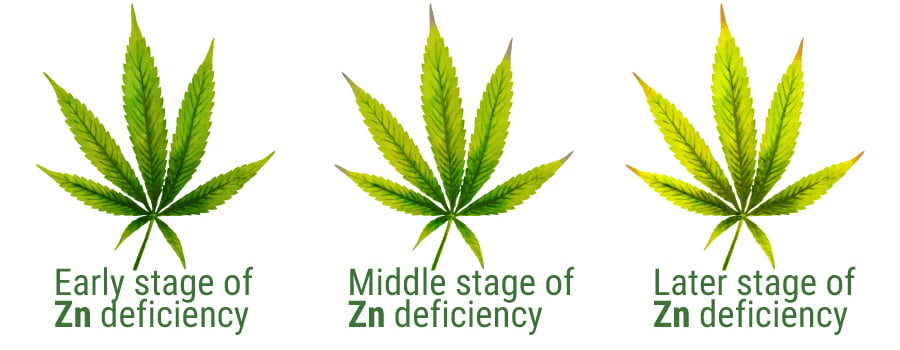
Unless you are growing in an entirely new or unknown type of soil, the most common cause of zinc deficiency in marijuana is water pH imbalance. As pH becomes too alkaline, the roots become incapable of absorbing this mineral trace element. Other micronutrients like manganese and copper quickly become unavailable. Nitrogen and calcium start getting affected too.
If growing organically, your pH range is much more permissible than when using chemical fertilisers. Nevertheless it very important to control - something organic growers tend to disregard.
The main disadvantage of organic growing is that correcting deficiencies can take a lot more time. So the best solution is prevention. Keep monitoring your pH! Since organic growing is so permissive regarding pH, growers tend to stop checking their primary water source. In some regions, be it municipal or well water, pH can fluctuate up to 3 to 4 points within the same year.
A sudden influx of phosphorus can also cause a zinc lockout in weed. Are you a hydroponic expert grower that cannot explain why you are getting this deficiency all of a sudden? pH meters routinely calibrated, everything seems dialled in as always? It could be as simple as you having run out of nitric acid and switched over to phosphoric acid as pH-down. In excessively hard water regions, a high limestone and chalk content is calcium and magnesium rich, making for a strong pH buffer. Your once nitric acid stable system now uses significant amounts of phosphoric acid to deal with that strong alkaline water. This type of Phosphorous is readily available for intake by the plant, potentially pushing it into a zinc deficiency.

